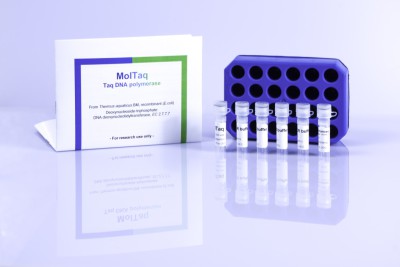
Standard PCR Reagents
Useful for a range of PCR operations, Moltaq plays a crucial role in amplification of DNA for many applications. As an example, in Single-nucleotide polymorphism, Moltaq sees uses for quality measurement of food and water, for gene mutation research, and many others.
A variety of kits are available depending on your need. These kits will meet your needs for high performance PCR amplification in daily routine. MolTaq is the standard Taq DNA polymerase kit supplying PCR buffer (1.5mM MgSO4) and PCR enhancer for high G+C content targets.
MolTaq Basic enables optimization of PCR amplification by variation of Mg2+ concentration (basic buffer and extra 100 mM MgCl2 solution). Control of accurate pipetting and direct transfer of the amplification reaction to the gel for analysis is possible using MolTaqRED and MolTaqRED basic, respectively.
Catalog Numbers
|
Catalog #
|
Test Description | |
|
P-010-1000 P-010-5000 P-016-1000 P-016-5000 P-017-1000 P-017-5000 P-040-1000 P-040-5000 P-060-1000 P-060-5000
|
MolTaq – Thermostable DNA Polymerase (1000 Reactions)
MolTaq – Thermostable DNA Polymerase (5000 Reactions) MolTaq Basic – Thermostable DNA Polymerase ¹ (1000 Reactions) MolTaq Basic – Thermostable DNA Polymerase¹ (1000 Reactions) Hot MolTaq – Hot start Thermostable DNA Polymerase (1000 Reactions) Hot MolTaq – Hot start Thermostable DNA Polymerase (1000 Reactions) MolTaq Red – Basic Thermostable DNA Polymerase¹ (1000 Reactions) MolTaq Red – Basic Thermostable DNA Polymerase¹ (1000 Reactions) Hot MolTaq – Basic Hot start thermostable DNA Polymerase (1000 Reactions) Hot MolTaq – Basic Hot start thermostable DNA Polymerase (1000 Reactions) ¹: Mg(2+) supplied separately ²: Red dye for visualization |
Publications
Phenotypic variability in RDH5 retinopathy (Fundus Albipunctatus) (Sergouniotis P, 2011)
Composition of epiphytic bacterial communities differs on petals and leaves (Junker R, 2011)
Novel mutations in MERTK associated with childhood onset rodcone dystrophy (Mackay D, 2010)
Glacial-driven vicariance in the amphipod Gammarus duebeni (Krebes L, 2010)